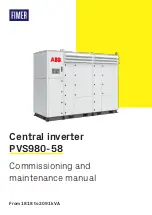
2. Battery chargers that have a warning label stating that dangerous voltages are present at the
battery terminals.
The majority of portable appliances do not have this problem. Most portable appliances use separate
transformers or chargers that plug into AC receptacles to supply a low DC or AC voltage output to the
appliance. If the appliance label states that the charger or adapter produces a low DC or AC voltage
output (30 volts or less), there should be no problem powering that charger or adapter.
Some fluorescent lamps may not operate properly with this type of inverter. If the bulb appears to be too
bright, or fails to light, do not use the lamp with this inverter.
Some fans with synchronous motors may slightly increase in speed (RPM) when powered by the inverter.
This is not harmful to the fan or to the inverter.
Important Cable Information
Substantial power loss and reduced battery operating time result from inverters installed with cables that
are not able to supply full power. Symptoms of low battery power can result from cables that are either
excessively long or an insufficient gauge. Marine installations are also subjected to vibration and stresses
that exceed those of other mobile installations. Therefore, the installer/operator should be especially
aware of the requirements to maintain secure, tight, water-resistant electrical connections and to provide
for strain relief for DC cables and appliance wiring. Cable insulation must be the appropriate type for
the environment.
Read All Instructions Before Using This Power Inverter!
SAVE THESE INSTRUCTIONS
IMPORTANT SAFETY INSTRUCTIONS
WARNINGS
TO REDUCE THE RISK OF FIRE, ELECTRIC SHOCK, EXPLOSION OR INJURY:
• Disconnect inverter before attempting any maintenance or cleaning. Turning off
controls will not reduce the risk of electric shock.
• NEVER connect to AC distribution wiring.
• Remove appliance plug from outlet strip or turn off inverter before working on the
appliance. Multiple outlet power strips with switches and circuit breakers only
interrupt power to the "hot" receptacle terminals. The "neutral" terminals remain
powered with respect to the "ground" terminals.
• Do not open — there are no user-serviceable parts inside. Return to manufacturer or
take to a qualified service technician when service or repair is required. Incorrect
reassembly may result in a risk of electric shock or fire.
• DO NOT make any electrical connections or disconnections in areas designated as
IGNITION PROTECTED. This inverter is NOT approved for ignition protected areas.
• Do not install in compartments containing batteries or flammable materials. This
equipment employs components that tend to produce arcs or sparks.
• Use this unit in properly ventilated areas ONLY.
• Do not insert foreign objects into the outlets.
• Do not expose the unit to liquids, including water, rain or snow.
• Do not attempt to install or operate this unit while operating a motor vehicle.
• This is not a toy — keep away from children.
FOR USAGE ABOVE 80 WATTS:
• Use battery clips ONLY.
• DO NOT use the DC accessory plug or the fuse will open.
CAUTIONS
• Always inspect battery supply connections and cables to ensure they are tight and that cable insulation
is not damaged.
• Do not use with positive ground electrical systems.* Reverse polarity connection will result in a blown
fuse and may cause permanent damage to the inverter and will void warranty.
*Most modern automobiles, RVs, trucks and boats are negative ground and can be used with this inverter.
• Grounding the Neutral will cause the inverter to shut down. Do not operate this inverter if it is wet. Do
not install in engine compartment — install in a well ventilated area.
• This inverter has not been not tested for use with medical devices.
BATTERY PRECAUTIONS
• Someone capable of being of assistance should be within the range of your voice or near enough to
come to your aid when you work on or near a lead-acid battery.
• Have fresh soap and water nearby. If battery acid contacts skin or clothing, immediately wash with
soap and water. If acid enters eye, flood the eye with cold running water for 10 minutes and
immediately seek medical attention.
• NEVER smoke or allow a spark or flame in the vicinity of the battery.
• Remove personal metal items, such as rings, bracelets, necklaces and watches when working with a
lead-acid battery. These conduct electricity. A lead-acid battery can produce a short circuit current
high enough to cause a severe burn.
APPLIANCE PRECAUTIONS
NEVER plug in battery chargers for cordless power tools if the charger carries a warning that dangerous
voltages are present at the battery terminals.
NEVER plug small appliances directly into the inverter outlets to recharge nickel-cadmium batteries.
Always use the charger provided with the appliance.
Certain chargers for small nickel-cadmium batteries can be damaged if plugged into the inverters. DO
NOT use inverters with the following two types of equipment.
1. Small, battery-operated appliances such as flashlights, cordless razors and toothbrushes that can
be plugged directly into an AC receptacle to recharge.
VEC034B_ManualEN_021406 2/17/06 10:06 AM Page ii
























